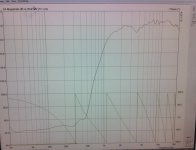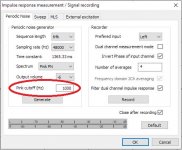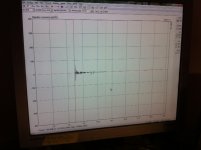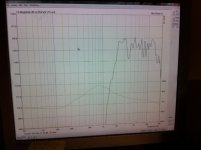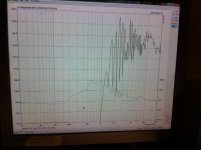Attached farfield Tweeter HighPass LR4 at 1KHz. Still not good enough if the final XO at 2.5KHz? Does begin to slope down around 2KHz
If at this stage I'm not going to take into consideration off axis responses, should I now start to measure in HFD? Would I then be able to design filters easier in the graphic screen?
If at this stage I'm not going to take into consideration off axis responses, should I now start to measure in HFD? Would I then be able to design filters easier in the graphic screen?
Attachments
Attached farfield Tweeter HighPass LR4 at 1KHz. Still not good enough if the final XO at 2.5KHz? Does begin to slope down around 2KHz
If at this stage I'm not going to take into consideration off axis responses, should I now start to measure in HFD? Would I then be able to design filters easier in the graphic screen?
If you saved that measurement then please generate a target response overlay to it, like be seen in the following picture, and you can check yourself or post that overlayed response. Optimally, the target response and your tweeter's response would be exactly the same.
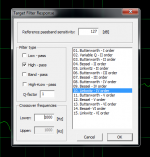
Last edited:
I cannot overlay but can note down curves.
By the way, with target curve high pass, I didn't think that lower crossover freq would make a difference. Only high crossover freq. It actually does affect the curve if you enter a different lower crossover freq???? For the purposes of this exercise I entered high crossover freq 1000 and lower crossover freq 1000 too
Natural curve of tweeter acording to manufacturer
Starts sloping at 2KHz
at 700Hz = -10dB
at 400Hz = -20dB
Target curve with LR4 at 1KHz (though final XO will be at 2.5KHz)
Starts sloping at 2 to 3KHz
at 800Hz = -10dB
at 600Hz = -20dB
My measured curve with LR4 at 1KHz
Starts sloping at approx 2KHz
at 900Hz = -10dB
at 650Hz = -20dB
Measured is a bit steeper than Target and natural, I suppose because natural and crossover are summed?
By the way, with target curve high pass, I didn't think that lower crossover freq would make a difference. Only high crossover freq. It actually does affect the curve if you enter a different lower crossover freq???? For the purposes of this exercise I entered high crossover freq 1000 and lower crossover freq 1000 too
Natural curve of tweeter acording to manufacturer
Starts sloping at 2KHz
at 700Hz = -10dB
at 400Hz = -20dB
Target curve with LR4 at 1KHz (though final XO will be at 2.5KHz)
Starts sloping at 2 to 3KHz
at 800Hz = -10dB
at 600Hz = -20dB
My measured curve with LR4 at 1KHz
Starts sloping at approx 2KHz
at 900Hz = -10dB
at 650Hz = -20dB
Measured is a bit steeper than Target and natural, I suppose because natural and crossover are summed?
So we still do not know what is your tweeter's natural response in your situation. It looks different than in the published datasheet, even if we consider your 1kHz LR4 highpass filter.
If you want "better" crossover than your previous passive, it would be great to know your tweeter's response, or you need to learn how to generate target response in ARTA. In HFD you need to flatten the response first (without crossover) because it doesn't have target response generator.
If you want "better" crossover than your previous passive, it would be great to know your tweeter's response, or you need to learn how to generate target response in ARTA. In HFD you need to flatten the response first (without crossover) because it doesn't have target response generator.
Will Farfield measurement of tweeter with LR4 at 500Hz be OK for "natural response? I guess that the final XO freq will be 2.2K to 2.5K
Should I measure in ARTA or HFD?
Should I measure in ARTA or HFD?
Hi Steve!
LR4 at 500Hz would be ok for an xo point 2kHz and up.
You can measure either with ARTA or with HFD. ARTA have more options measurement wise (averaging, using overlay etc.), but with HFD you can more easily visualize the response shaping.
You still don't have to do the measurement too loud, you can measure the frequency response well below normal listening levels.
LR4 at 500Hz would be ok for an xo point 2kHz and up.
You can measure either with ARTA or with HFD. ARTA have more options measurement wise (averaging, using overlay etc.), but with HFD you can more easily visualize the response shaping.
You still don't have to do the measurement too loud, you can measure the frequency response well below normal listening levels.
Last edited:
Measuring far-field is not ideal, if that's what you mean.Will Farfield measurement
Measuring far-field is not ideal, if that's what you mean.
Hi
How do you suggest it's measured?
I assume you want to get away with one measurement per driver, so I would start by calculating the difference in the driver distances at the listening position, then find a spot around 1m away from the speaker that keeps that difference. I'd start with a measurement at 20 degrees off-axis, and I'd position it in the room so I could gate the measurement to remove the room. Then when listening, I'd position the speaker to reduce the room effect, and rotate it to set the tonal balance.
This of course, is highly oversimplified.
This of course, is highly oversimplified.
Hi Steve,
Are you aware of the "Pink Cutoff(Hz) function in ARTA that has a selectable HP filter used for making measurements on tweeters?
When a measurement is made with this function set to say 1KHz, the inverse of this function is then applied to the data after aquisition. This provides you with a frequency response of the speaker without the response of the 1KHz filter!
So you don't need to apply a 1KHz crossover to the tweeter in order to protect it from excesive low frequency excursion.
Peter
Are you aware of the "Pink Cutoff(Hz) function in ARTA that has a selectable HP filter used for making measurements on tweeters?
When a measurement is made with this function set to say 1KHz, the inverse of this function is then applied to the data after aquisition. This provides you with a frequency response of the speaker without the response of the 1KHz filter!
So you don't need to apply a 1KHz crossover to the tweeter in order to protect it from excesive low frequency excursion.
Peter
Attachments
Hi Peter,
No was not aware. But I see that it is not available under "Sweep"?
Not used Pink Noise for measurement before
No was not aware. But I see that it is not available under "Sweep"?
Not used Pink Noise for measurement before
Set up my living room for measurements again.
Just a few questions on ARTA set up.
I'm going to be measuring Tweeter, Farfield (1meter)
Going to risk HighPass LR4 at as low as 500Hz. (don''t know how to do with Pink Noise, Peter, as other drivers measured with Sweep)
ARTA Impulse response measurement/ Signal recording Window
Under Sweep generator:
Sequence length, 16K to 256K which and why?
Sample rate, I presume 48000?
Output Volume 0?
Log freq sweep - tick or not?
If later measure with Hypex FD (not done before) anything to consider?
Just a few questions on ARTA set up.
I'm going to be measuring Tweeter, Farfield (1meter)
Going to risk HighPass LR4 at as low as 500Hz. (don''t know how to do with Pink Noise, Peter, as other drivers measured with Sweep)
ARTA Impulse response measurement/ Signal recording Window
Under Sweep generator:
Sequence length, 16K to 256K which and why?
Sample rate, I presume 48000?
Output Volume 0?
Log freq sweep - tick or not?
If later measure with Hypex FD (not done before) anything to consider?
Sweep is good, it allows you to gate.
Regarding length.
0=0dB, normal full output.
Choose log sweep.
Regarding length.
0=0dB, normal full output.
Choose log sweep.
Focal confirm TD5 XO at 2.5KHz (not 2KHz) You were right YSDR!
Also 15WX XO OK at 500Hz
ATC confirm they use range for SM 75-150S of 380Hz to 3.5KHz
If I use XO freq of 2.5KHz for the TD5, is the tweeter measurement in Post 201 with highpass at 1KHz good enough? The Highpass at 1KHz seems to affect the response from 2K downwards
Also 15WX XO OK at 500Hz
ATC confirm they use range for SM 75-150S of 380Hz to 3.5KHz
If I use XO freq of 2.5KHz for the TD5, is the tweeter measurement in Post 201 with highpass at 1KHz good enough? The Highpass at 1KHz seems to affect the response from 2K downwards
Yes, 1kHz highpass is usable for measurements for 2kHz and up, 2.5kHz and up is even better imo. My advice for xo point is still somewhere 2.5-3kHz.
Here is two 1kHz highpass response, one with BW2 (2nd order Q=0.71) and one with LR4 (two cascaded 2nd order BW2) for help.
As we an see even the LR4 is only around 0.5dB down at 2kHz. You can create these target responses in ARTA with ease, and it's useful.
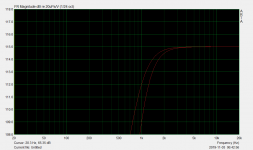
Here is two 1kHz highpass response, one with BW2 (2nd order Q=0.71) and one with LR4 (two cascaded 2nd order BW2) for help.
As we an see even the LR4 is only around 0.5dB down at 2kHz. You can create these target responses in ARTA with ease, and it's useful.

Just some questions on ARTA
When try to truncate impulse measurement get:
Error:Gated length < 128samples
Need to go beyond 1st reflection in order to not get that message. See attached Trunc.jpg
Then with smoothing 1/1 get approx +/- 1dB see smooth1-1.jpg
with smoothing 1/24 get approx +/- 7dB of the same measurement See 1-24.jpg
When try to truncate impulse measurement get:
Error:Gated length < 128samples
Need to go beyond 1st reflection in order to not get that message. See attached Trunc.jpg
Then with smoothing 1/1 get approx +/- 1dB see smooth1-1.jpg
with smoothing 1/24 get approx +/- 7dB of the same measurement See 1-24.jpg
Attachments
64k Sequence length is enough, but your impulse response looks strange to me. Please add little more gain in ARTA for better visualization.
- Home
- Loudspeakers
- Multi-Way
- Freq measurements and Hypex Filter Design adjustments
